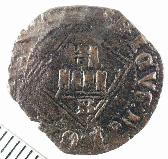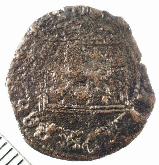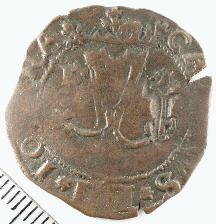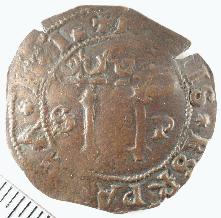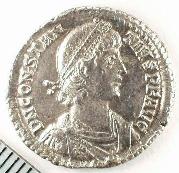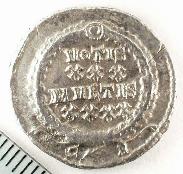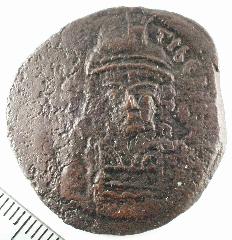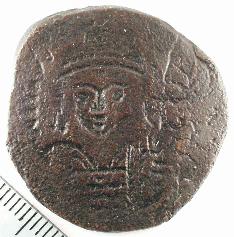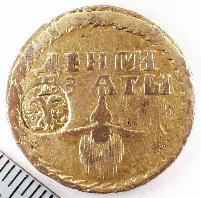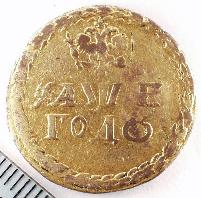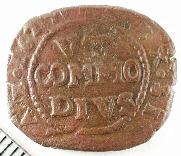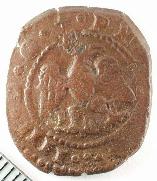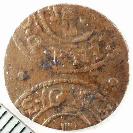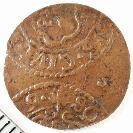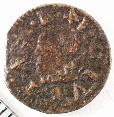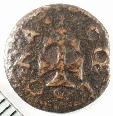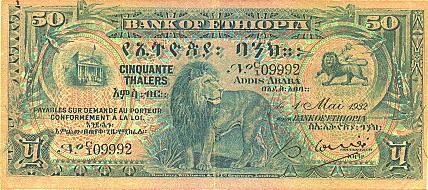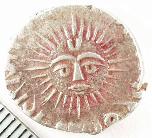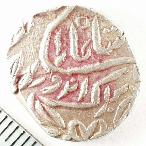Chatter
archive
also available
| Chicago Coin Club |
|---|
| Volume 48 No. 6 |
June 2002 |
|---|
Minutes of the 1001th Meeting
The 1001st meeting of the Chicago Coin Club was called to order on May 8, 2002 at 7:02PM by President
Carl Wolf. The meeting was held at 1 Bank One Plaza.
A motion was made, seconded and passed to approve the March and April meeting minutes as they
appeared in the Chatter.
Secretary/Treasurer Lyle Daly gave a treasury report as follows:
| Dreyfus Money Market |
$1845.22 |
| Bank One CD |
1408.09 |
| Bank One CD |
1437.59 |
| TCF Checking Account |
1529.00 |
| Un-deposited Funds |
338.00 |
| TOTAL |
$6,558.06 |
Vice President Bob Feiler introduced our featured speaker Bruno Rzepka, and his topic The Art of Steel
Engravings.
Bruno Rzepka started collecting at age 13 when his father gave him a purse full of coins ranging from
Indian cents to silver dollars. As a child, he was given gold coins by his godparents for communion,
graduation, and various holidays. Groans were heard from the membership when we were advised that his
mother dutifully turned in the gold when Franklin Roosevelt took the U.S off the gold standard.
During WWII, Bruno was in the U.S. Navy in Vega Venturas in the Aleutians. Later as Crew Chief and
Captain, he flew a B-24 Liberator and was awarded the Distinguished Flying Cross and 5 air medals.
Bruno, like many of his fellow veterans of WWII collected paper money while overseas in a "short
snorter". His included the signatures of Jack Benny and Carol Landis.
After the war, he served an apprenticeship as tool and die maker. He eventually became a tool inspector.
He worked for Signode Corporation in Glenview for 22 years and took early retirement at age 60.
Also after the war, Bruno resumed collecting. He began to complete sets of coins. He met Glenn Smedley
around 1962. Glenn became his mentor. About this time he bought his first printing error and met Jim
Grebinger. He collaborated with Jim on the error section of Donlon's book on small size currency. 75% of
the notes shown in that book belonged in Bruno's collection. In all, Bruno accumulated over 1400 error
notes, among them a double denomination ($5.00 front mated with $10.00 back). Bruno met Tom
Hipschen, portrait engraver at the Bureau of Engraving, in 1992 at the Stamp Expo in Rosemont. Tom was
good enough to provide a listing of engravings that he was involved with. Bruno bought 75 first day covers.
Tom was good enough to autograph them all.
Bruno is the past President of the Tree Towns Coin Club (Elmhurst), the Oak Park Coin Club, and charter
member of the Morton Grove Coin Club. He is also a member of the Chicago Coin Club, Itasca Coin Club,
and Hillside Coin Club. He is a 40 year member of the ANA, and belongs to the Souvenir Card Collector
Society, and the Society of Paper Money Collectors.
Before Bruno could begin his talk, the membership asked him to display his service medals. In appreciation
for his contribution to our nation, he received a round of applause.
Bruno began his talk by explaining how a steel engraving was carved out of a piece of annealed steel which
is relatively soft. Each line must be individually carved with a burin, or engraving tool. After the "curls" of
steel are removed, the sharp surfaces of the steel plate are removed with a wet stone. At intervals of
completion, the artist will take a series of proofs to test the plate and map his progress. If an error is made
before the plate is one third complete, the plate is typically destroyed. If the plate is more than a third
complete, the artisan will drill out a portion of the back of the plate and "bump out" the site of the mistake
and re-engrave the plate with the additional metal that was forced to the surface.
Bruno noted that the recent engravings will not have serial numbers while the older ones do. Earlier
engravings tended to be small. There are three types or areas of specialization for engravers: plate, number
and scroll work designs.
Bruno had the good fortune to correspond with Tom Hipschen, Chief Engraver at the Bureau of Engraving
and Printing. Mr. Hipschen engraved numerous presidential portraits.
Bruno presented engravings from his collection which included Jefferson Davis, Robert E. Lee and
Abraham Lincoln. He had portrait engravings of numerous Civil War Generals and one of Cadet Stonewall
Jackson. Bruno concluded his talk with the display of an 1875 engraving of the Declaration of
Independence. This was the same vignette used on the back of the series 1976 $2 dollar.
Vice President Bob Feiler thanked Bruno for his presentation and awarded the featured speakers medal
and the educational certificate to him. Bruno was originally scheduled to speak on September 12, 2001. The
speaker's medal carried both dates.
Two guests were present: Andrius Plioplys and Steve Norton.
Second Vice President Don Dool announced there were 12 show & tell presenters:
-
Bob Feiler - Macon GA $5 note and a set of gold plated California gold tokens (Replica 1965)
-
Reid Geisler - a 1974 quarter on a nickel planchet and an Ohio Quarter on a nickel planchet
-
Mike Metras - 1932 Ethiopian bank note, Indor sun coin, and a lighter replicating a 5 franc
coin
-
Sharon Blocker - Jamaican bimetallic coin, Commemorative Mexican peso and Mexican medal
commemorating the Aztec calendar
-
Carl Wolf - merchant's bead cards and an informative history of trade beads in the US.
-
Robert Leonard - examples of the three types of coins used in the New World as evidenced by
archeological excavations in the Dominican Republic
-
Bob Weinstein - Engraved prescription forms for alcohol from Prohibition, NY Prohibition Medal
dated 7/4/1854, silver Washington Medal, Grover Cleveland medal from the
Columbian Expo.
-
Richard Hamilton - Mortgage Bond from Sleeping Parlor Coach Co and a stock certificate from
Pennsylvania Railroad with restrictions on ownership by Japan or Germany
-
Andy Plioplys - 3 Lithuanian silver bars 12th -14th century.
-
Mark Weiclaw - 3 Byzantine coins and a Russian beard token
-
Bruno Rezpka - Letter from Dr Davenport dated 11/16/1965
-
Don Dool - 4 coins purchased at CICF from the 14th & 15th century
Reading of Applications for Membership:
A first reading for membership was made for Steve Norton who was present.
The following candidates for membership had their names read for a second time: Thomas J. Pupp,
Fidencio Parevez, Jeffery Amelse, Dale Noble, Doug Scrimager, David Tsujimoto, Dennis Coughlin, Paul
Johnson, Katie DiCosta and Andrius Plioplys. A motion was made, seconded and passed to approve their
membership.
Old Business:
President Carl Wolf advised the club that Steve Album extended his apologies for the absence of his slides
at the afternoon presentation of the 1000th meeting. Family illness prevented him from preparing that portion
of his talk. A club member commented and the members agreed that that no apology was necessary. His talk
was appreciated.
Mark Wieclaw presented to the club archives, the silver 1000th meeting medal #1, the "gold select" medal
#100 and the lead trial strike. A round of applause was given to Mark and all the committee members for
their outstanding effort.
Bill Burd announced that the CCC has received a commemorative medal and program from the New York
Numismatic Club from their 1000th meeting. The CCC thanks the NYNC. These materials will be
forwarded to the archives.
A motion was made, seconded and passed to print an additional 100 program booklets for new members
at a cost of $247.82.
Carl Wolf announced that the "Gold Dust Currency" was nominated for a creative award by the mill that
made the paper.
Mark Wieclaw announced that a drawing for a gold elongated coin was overlooked at the 1000th meeting.
A drawing was made from the sign in registry and Dave Simpson won. CONGRADULATIONS DAVE!
Mark Wieclaw presented lead strikes of the Medal commemorating the 1000th meeting to Bill Burd and
Sharon and Kevin Blocker as the committee chairman's gift to the committee members. (Bill, Sharon &
Kevin were not able to attend the wrap up meeting.)
President Carl Wolf announced that Lyle Daly and Steve Zitowsky will develop a summary financial report
on the 1000th meeting.
New Business:
Carl Wolf announced that he would call a Board of Directors meeting in the near future to discuss the
contents of the Archives, Safe Deposit Box and new banquet sites.
Robert Leonard reported on possible topics for the 2003 CICF giveaway which included "Baghdad Bread"
money and "Salt & Pepper" money.
Lyle Daly reported that all paid members will be receiving their 2002 membership card with their Chatter.
A reminder letter to those who have not paid will be sent in June.
Deed of Gift documents were received by the ANA for the 1000th meeting medal and will be completed
and returned.
Life membership fee was received by the club for Michael Brodsky. The application was referred to the life
membership committee.
John Connolly noted that the State auction of the contents of the abandoned safe deposit boxes brought
prices well over gray sheet and suggested attendance would not be beneficial.
President Carl Wolf noted that John Connolly was the only member who remembered a camera for our
1000th meeting and offered a round of applause for John.
Finally Mark Wieclaw noted to membership the unwavering determination and support that President Carl
Wolf gave to the 1000th meeting planning and implementation effort. Mr. Wolf was totally involved in all
aspects of the event. Carl received a well deserved round of applause.
The meeting was adjourned at 9:43 p.m.
Respectfully submitted by Lyle Daly
Speaker's Wor[l]d
The Art of Steel Engravings
Presented by Bruno Rzepka to our May 8, 2002 meeting.
To better share his appreciation of steel engraving with us,
Bruno brought a large box of items.
Jeff Rosinia was kept busy operating the camera,
allowing us to see the items on the large screen television.
Among the highlights of his long involvement in paper money
were his collaborating with Jim Grebinger on the error section
of Donlon's book on small size currency (where 75% of the pictured
notes were from Bruno's collection),
and when Aubrey Bebee signed his pictured error note
in Donlon's book.
Having been encouraged to bring them,
Bruno then was prompted from the audience
to show his WW II Navy medals:
an Air Medal with 4 stars, and the Distinguished Flying Cross.
Getting back to the main topic, he showed the first
steel engraving of the evening, one he had acquired
two years ago in Scotland.
It was dated 1765.
Although most people think of steel as a hard metal,
it can be softened by a heat treatment;
Bruno likened the result as comparable to cold butter.
Shallow cuttings then can be made in the steel with a graver,
a tool with a small V-shaped point.
After a few cuts, the plate is wiped with a whetstone
to remove the burrs resulting from the cuts;
the burrs are sharp enoughto cut a finger.
After part of the design is entered,
a spider press is used to print the plate (resulting in a proof)
to verify the current image.
Bruno showed some prints with some details complete
and with others only lightly sketched in,
showing the interactive nature of creating a plate.
Even when softened, a steel plate is not conducive to the fixing of mistakes.
If an error is made before much of the design is entered,
the entire plate might be scrapped.
For plates with much work already done,
Bruno explained how an error typically is corrected.
First, a hole is drilled from the rear of the plate,
but not all the way through.
Next, a hammer and chissel are used from the rear to
push metal back up to the surface,
where finally it is wiped with a whetstone to smooth it.
Why go through all this effort?
Bruno showed examples produced by steel plates and woodcuts,
to convince us that the extra effort is worth it.
Having explained the main aspects of plate production,
Bruno proceded to discuss the use of plates by printers.
A large bond with many vignettes might be run through a press many times,
using one vignette on each pass.
The frame, scrollwork, and other design elements might each be added
on their own pass.
This allowed for re-use of elements on later items.
However, current US paper money is produced from plates
which are two steps removed from the original hand-engraved components,
so that multiple images of complete bills are found on the current intaglio printing plate.
To help explain prodution of current US money,
Bruno distributed copies of the Bureau of Engraving and Printing's
The Money Factory flyer.
The engravers are a good source of information,
and Bruno spent some time on the biographies of of Thomas R. Hipschen
and Tom Spiewak, and showed Spiewak's engraved business card
identifying him as a plate engraver for the BEP.
The souvenir printings from various shows give us the
opportunity to meet these skilled people and discuss their work.
Bruno met Tom Hipschen at the Ameripex '86 show;
Tom had engraved about half of the presidents on the presidential stamp set,
and Tom graciously signed all of the sheets that Bruno had bought.
But not all government employees are as open with collectors,
as when Bruno described how, years ago,
he had torn up and thrown away a letter from the Treasury Department stating,
"We do not make mistakes,"
in response to some questions from Bruno.
Eagles and Lincoln are Bruno's favorite subjects,
and he showed prints of those as well as various Civil War figures.
Although many engravings are known of Lincoln,
Bruno knows of only one without a beard,
and that is in a book.
But, he continues the search.
It seemed as if every piece had an interesting story behind its acquisition.
Bruno showed a large railroad bond, printed by the Franklin Banknote Company,
with everything steel engraved, even the lettering and the coupons.
He had acquired it at a flea market from a dealer with 8 of them,
priced at three for $1;
but the dealer would sell him only three bonds!
At a flea market in San Jose, $28 bought a group of prints of
individual Civil War officers, such as Beauregard, Ronbeau, and others.
Bruno later sold the Robert E. Lee print for $50 to someone
who already had an autographed letter of Lee.
A Virginia City, California antique shop had a framed engraving
in the window, and a note, "Call this number to open the store."
Bruno called, and $22.50 bought an 1875 engraved print of the
signing of the Declaration of Independence,
at least 4 by 7 inches in size.
Tom Hipschen estimated it would take about one and a half years
to engrave the scene (the same scene appears on the back of the US $2 bill).
Bruno later was offered $125 for just the frame and glass (bubbles in the glass
indicate it to be contemporary with the print).
There was more, but you get the idea that a good time was had by all.
Show and Tell
Each image has a scale in the lower-left corner,
with the tics spaced 1 mm apart.
Because the brightness and contrast were manipulated on a computer,
the coloring of a coin's image differs from the coin's actual coloring.
-
Bob Feiler
started us off with pieces acquired at some shows:
-
A $5 Macon, Georgia Manufacturer's Bank note
with a vignette that had caught his eye.
-
From a Milwaukee show, a 10-piece California gold type set.
Gold plated, and made in the early 1960s by Peach Tree coins.
-
Recently acquired error coins were shown by
Reid Geisler.
-
A 1974 quarter received in change, it was struck on a nickel planchet
and has a partial reeded edge.
-
An Ohio quarter on a nickel planchet.
-
Mike Metras
showed a range of items:
-
From the CICF auction, a cinquante thalers, Bank of Ethiopia
paper money, of the 1932-1935 series.
-
On the CICF bourse, this Sun face of Indor, India
shouted out to Mike.
-
At a flea market, a cigarette lighter made out of a
French 5 franc coin.
-
A purchase at a Jamaica Airport gave
Sharon Blocker
a pleasant surprise, when her expected change of $11.50
was paid as $11, but with a $20 bimetallic piece instead of
the expected half dollar.
She also showed
-
A Mexican coin honoring the 350th anniversary of coinage.
-
A 1993 medal with an Aztec calendar on the obverse
and renditions of coins on the reverse.
-
Carl Wolf
showed a White Heart trade bead from Venice, 17-19th centuries,
and explained that one should not buy trade beads for much money
as there is no proof of originality.
Much of the current information on trade beads comes from bead collectors,
but they do not care too much about their numismatic usage.
The White Heart bead also is known as the New Hudson's Bay bead,
since it was used after the beads with a green center that Carl
had shown at an earlier meeting.
-
Early coinage of Hispaniola was discussed by
Bob Leonard
who started with the settlement of La Isabela, founded
in 1494 by Christopher Columbus and abondoned in 1497
when Santo Domingo was founded on the southern coast.
-
Excavations at La Isabela produced 76 coins which were
reported in the Numismatist in 1992, with some
pieces illustrated.
Bob showed a similar billon piece of Henry IV (the
prior king) that he recently acquired from Spain, and costing
less than $20.
-
A copper cuartilla minted in Santo Domingo from
1542 to 1600, originally valued at 4 maravedis.
-
A similar cuartilla, but countermarked with a key
to indicate a re-re-valuation from 1 to 2 maravedis.
-
Bob Weinstein
showed no ancient coins, but still covered a wide range:
-
A prescription form for liquor, one of the lesser known
products of the Bureau of Engraving.
It is an unused original, with carbon copy.
The unused forms are harder to find,
but there are about 20 offered per week on eBay.
It appears that much liquor was used for medicinal
purposes during Prohibition.
-
A July 4, 1855 medal supporting local temperance in New York.
This is not common, as most temperance medals originated in England.
-
A silver George Washington mint medal, holed and with a loop.
-
A 100th anniversary of American Independence medal, holed but fixed.
-
A Columbian Exposition Grover Cleveland medal in bronze,
to honor his visit.
-
Railroad related financial instruments were shown by
Richard Hamilton.
-
A 6% mortgage bearer bond of the Woodruff Sleeping Car Company.
-
Two stock certificates of the Pennsylvania Railroad, for 5 and 10 shares.
The interesting point of these is the 1947 certificate on the rear;
they are from Swiss banks and attest that these had not been owned
by German or Japanese nationals.
-
Andy Piopolus
showed two silver bars, cast from the 12th to the 14th
centuries in Lithuania.
After pointing out the chissel marks that appear on some,
he noted that the Russian word for chopping is ruble,
and kopeck is based on the Lithuanian word for chopping.
These pieces were used for marriage prices and
murder fines in lieu of the death sentence.
Andy concluded by showing a counterfeit piece.
-
Ancient coins were showed by
Mark Wieclaw
who concluded with a more recent piece.
-
A 120 nummi of Justinian I, 525-555, weighing 0.68 grams.
Silver was scarce at that time of the Byzantine Empire.
-
A Byzantine follis of Maurice Tiberius, but this is a brockage.
-
A silver coin of Constantius II, but its weight of 2.8 grams
makes it too heavy for a new siliqua.
-
A Russian beard token from 1705,
this could have cost up to 50 rubles for a noble.
This copper piece has a counterstamp and gold plating.
-
Bruno Rzepka
showed a November 16, 1965 letter from Dr. Davenport,
who was responding to questions regarding three German Thalers.
His reply contained some information, but he also
apologized in that he knew more about the large thalers.
-
Four acquisitions from CICF were shown by
Don Dool.
-
A 1571 denar of Brandenburg, issued under Albrecht Friedrich
(1569-1618). Probably billon. Saurma 5099.
-
Sicily, 1629, 1/2 sou.
-
Livonia, contemporary counterfeit copper solidus. Dated 1649 or 59?
From Suchawa in Moldavia, issued in name of Christina, 1632-1654. Struck
on misaligned roller dies.
Punched about 100% off center.
Livonia was
under Swedish rule at that time.
-
A 1641 menut or dinero from Solsona, Catalona, Spain.
One of about 18 locations that issued
coins in the name of Louis XIII during the French occupation of 1641-1642.
Note that the four (4) in date is retrograde.
More Notes from the 1000th Meeting
Dinner Toast
As President of the American Numismatic Association, I raise my glass on
behalf of the ANA's 30,000 members to congratulate the Chicago Coin Club on
its 1,000th meeting.
May we honor those who came before us, and extend our best wishes to
those who follow.
Good health, happiness, and numismatics.
Congratulatory Address
Thank you. Esteemed dignitaries, members and guests; as a member of
the
Chicago Coin Club, and President of the American Numismatic Association, I
am
honored to be here today.
Nearly 111 years ago in Chicago, the American Numismatic Association was
born, and, with its founding, numismatics began to reach out to the hearts
and minds of coin collectors everywhere.
An early member of the ANA once described the organization as a
"federation of local clubs and societies."
The Chicago Coin Club has been and remains today a pillar of strength in
the ANA's federation of clubs, and, as such, key to the continued success of
numismatics.
In recognition of all the support and assistance performed by this
organization to the benefit of the numismatic hobby, it is my pleasure and
honor to present the Chicago Coin Club, with a small token of gratitude, on
behalf of the members of the American Numismatic Association, and extend
their heart felt congratulations in celebration of your 1,000th meeting.
Thank You.
John Wilson, President, ANA
More Final Thoughts on the 1000th Meeting
Thank you for sending a copy of the Chicago Coin Club 1000th Meeting souvenir program. The document itself is a
living testament to the essential qualities required to be a distinguished and prestigious numismatic organization. The
timbers upon which the club's foundation was built many years ago had set the high standards which continue to this
day. I read names like Ripstra, Mehl, Boosel, Smedley, Hewitt, Sheldon, Eglit, Flower, Slabaugh; a list of "super stars"
to be sure. Several of whom emboss my own collecting interests. Oh yes! I know there are many more including the
many prominent members of today who are carrying on the tradition. Their contributions have not gone unnoticed.
Though not a member of the Chicago Coin Club, I have always felt its presence going back to when I first started
collecting in 1964. It was back then and remains today ... the club to belong to! I have several medallic issues from the
CCC and "Perspectives In Numismatics" maintains a prominent place in my library. I wouldn't sell or trade any of
them.
As the founding father of the Oak Forest Numismatic Society, my aim was to create a club which would some day be
as good as the Chicago Coin Club. That is quite a goal for any coin club. For you have set the standards by which all
are judged. This year we are celebrating our 25th anniversary and our 300th meeting in September. You have been our
model all the way.
I will make sure the souvenir program is passed around at our next meeting on May 3rd. I want the members to see and
feel the pride that radiates from within its pages, the communion of members and numismatics, and the rich numismatic
history of the Chicago Coin Club. It's all there between the covers.
In closing, I convey to you on behalf of the Oak Forest Numismatic Society, congratulations on your 1000th meeting;
Chicago's best, the mid-west's best, America's best ... the Chicago Coin Club.
Howard W. Ribbentrop, President, OFNS
Our 1002nd Meeting
| Date: | June 12, 2002 |
| Time: | 7:00 PM |
| Location: | Downtown Chicago
Please remember the security measures at our meeting building:
give a club officer the names of all your guests prior to the meeting day;
and everyone must show their photo-ID at the security desk. |
| Featured speaker: | Mark Wieclaw
- An Almost Complete Perspective on Numismatics |
| |
Different people bring different goals and perspectives to our hobby.
Join us as a past president of our club
looks at the hobby from his views as a collector,
coin dealer, club officer, and a show organizer.
|
Important Dates
| June |
12 |
CCC Meeting - Featured Speaker Mark Wieclaw on
An Almost Complete Perspective on Numismatics |
| June |
28-30 |
21st Annual MidAmerica Coin Expo
at the Donald E. Stephens Convention Center, 5555 North River Road, Rosemont.
Admission is $5.
|
Birthday and Year Joined
| July |
4 |
Chester Poderski |
| July |
12 |
Flemming Lyngbeck Hansen |
2000 |
| July |
13 |
Gerard Anaszewicz |
1981 |
| July |
19 |
Terry L. Capps |
1996 |
| July |
19 |
John R. Connolly |
1997 |
| July |
19 |
Richard S. Hamilton |
1986 |
| July |
20 |
Kermit W. Wasmer |
1997 |
| July |
27 |
David Simpson |
1980 |
Chatter Matter
All correspondence pertaining to Club matters
should be addressed to the Secretary and mailed to:
CHICAGO COIN CLUB
P.O. Box 2301
CHICAGO, IL 60690
Visit Our Web Site
http://www.ChicagoCoinClub.org/
Contacting Your Editor
| Paul Hybert
|
| prh@ece.iit.edu |
Club Officers
| Carl Wolf | - President |
| Robert Feiler | - First Vice President |
| Donald Dool | - Second Vice President |
| |
| Directors: | Lyle Daly
William Burd
Jeff Rosinia
Mark Wieclaw |
| |
| Other positions held are: |
| Lyle Daly | - Secretary Treasurer |
| Paul Hybert | - Chatter Editor |
| Phil Carrigan | - Archivist |
